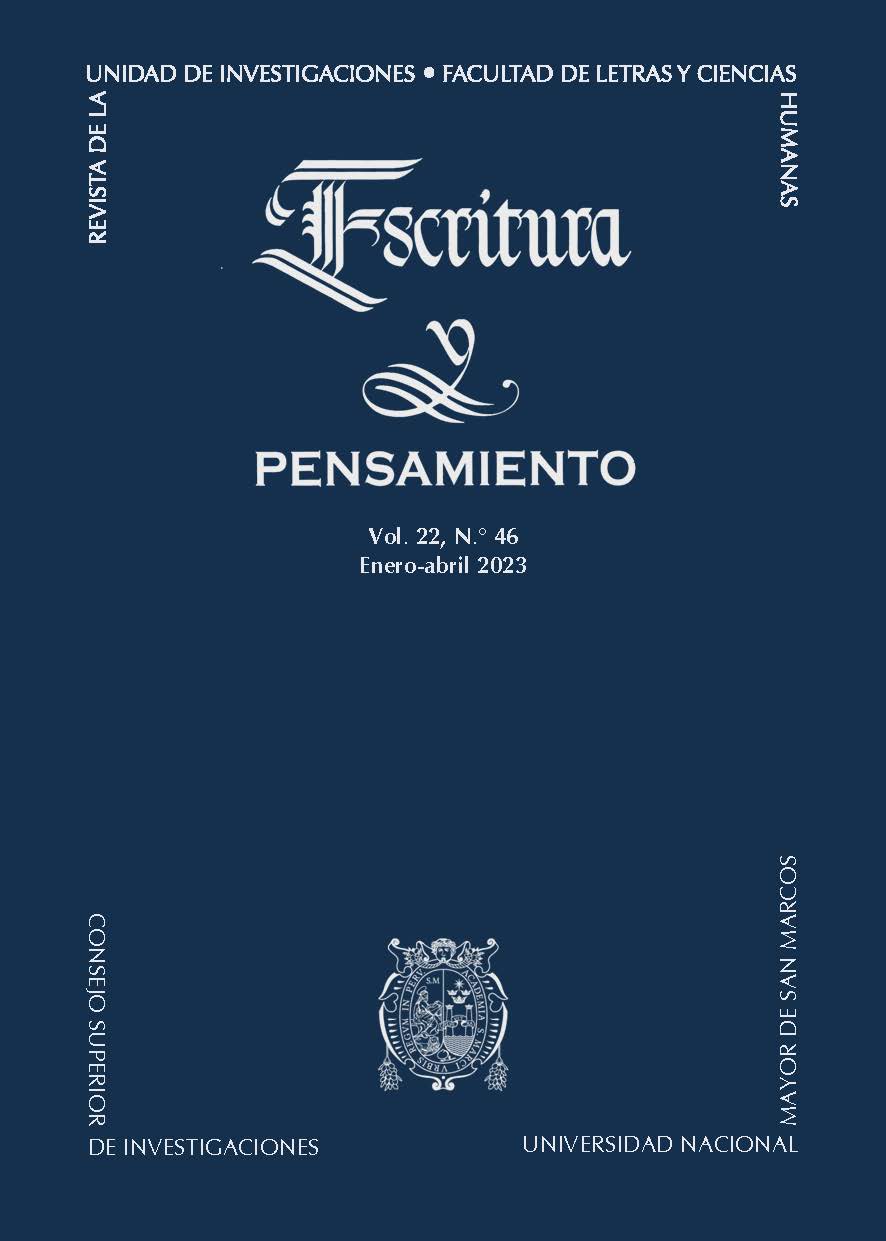La función de los espejos en ‘Elogio de la madrastra’ y ‘Los cuadernos de don Rigoberto’, de Mario Vargas Llosa
DOI:
https://doi.org/10.15381/escrypensam.v22i46.24569Palabras clave:
cuadros, cuadernos, erotismo, espejo, duplicación, madrastraResumen
Por su vinculación y propuesta de lectura continua, he denominado a Elogio de la madrastra (1988) y Los cuadernos de don Rigoberto (1997), en conjunto, «la obra erótica vargasllosiana» o «la novela del mirón». Su narrador nos invita a contemplar el escenario donde se desarrolla la historia semiincestuosa entre Lucrecia y Alfonso, y crea una obra de arte universal y clásico con cuadros, libros, arquitectura, música y, por supuesto, los cuadernos. Sobre la base teórica de Foucault (1968), Deleuze (2005) y Lacan (1998), planteo la siguiente hipótesis: la función de los espejos en «la novela del mirón» puede interpretarse, en efecto, como una herramienta voyerista, pero también como el lugar donde el ser se reconoce y, a la vez, se duplica. Tarde o temprano, los personajes de la gran obra se miran al espejo, se descubren, se desdoblan, se vuelven cuadros.
Referencias
Deleuze, G. (2005). La isla desierta y otros textos. Textos y entrevistas (1953-1974) [Trad. de J. L. Pardo]. Pre-Textos.
F. Lamarque, M. (2017). Fonchito y la luna: Eroticism in Mario Vargas Llosa’s Children Literature. Anuario de Investigación en Literatura Infantil y Juvenil, (15), 57-66. http://anilij.uvigo.es/wp-content/uploads/2018/05/AILIJ-2017.pdf
Fernández-Banineaux, M. (2010). El discurso contracultural: La Madre Santa y la madre sexual en Elogio de la madrastra de Mario Vargas Llosa. Espéculo. Revista de estudios literarios. http://www.ucm.es/info/especulo/numero45/madrevll.html
Foucault, M. (1968) Las palabras y las cosas, una arqueología de las ciencias humanas [Trad. de E. C. Frost]. Siglo XXI Editores.
Habra, H. (2001). Postmodernidad y reflexividad estética en Los Cuadernos de don Rigoberto. Chasqui: revista de literatura latinoamericana, 30(1), 81-93. https://doi.org/10.2307/29741642
Iwasaki, F. (2000). Lolita en los Andes: o Vargas en el ardor. Mester, 29(1), 126-132. https://doi.org/10.5070/M3291014539
Lacan, J. (1998). Escritos [Trad. al portugués de V. Ribeiro]. Zahar.
Martí-Peña, G. (2004). El teatro del ser: dualidad y desdoblamiento en la escenificación narrativa de Los cuadernos de don Rigoberto, de Mario Vargas Llosa. Revista Canadiense de Estudios Hispánicos, 28(2), 355-375. https://www.jstor.org/stable/27763922
Marting, D. E. (1998). Concealing Peru in Mario Vargas Llosa’s “Elogio de la Madrastra”. Chasqui: revista de literatura latinoamericana. 27(2), 38-53. https://www.jstor.org/stable/29741436
Vargas Llosa, M. (1999). Elogio de la madrastra. Peisa.
Vargas Llosa, M. (2016). Los cuadernos de don Rigoberto. Penguin Random House.
Publicado
Número
Sección
Licencia
Derechos de autor 2023 Katherine Pajuelo Lara

Esta obra está bajo una licencia internacional Creative Commons Atribución 4.0.
Los autores retienen sus derechos:
a. Los autores retienen sus derechos de marca y patente, y tambien sobre cualquier proceso o procedimiento descrito en el artículo.
b. Los autores retienen el derecho de compartir, copiar, distribuir, ejecutar y comunicar públicamente el articulo publicado en la revista Escritura y Pensamiento (por ejemplo, colocarlo en un repositorio institucional o publicarlo en un libro), con un reconocimiento de su publicación inicial en la revista Escritura y Pensamiento.
c. Los autores retienen el derecho a hacer una posterior publicación de su trabajo, de utilizar el artículo o cualquier parte de aquel (por ejemplo: una compilación de sus trabajos, notas para conferencias, tesis, o para un libro), siempre que indiquen la fuente de publicación (autores del trabajo, revista, volumen, numero y fecha).





